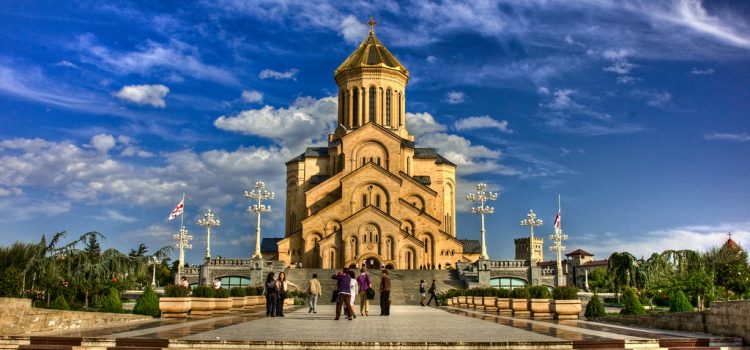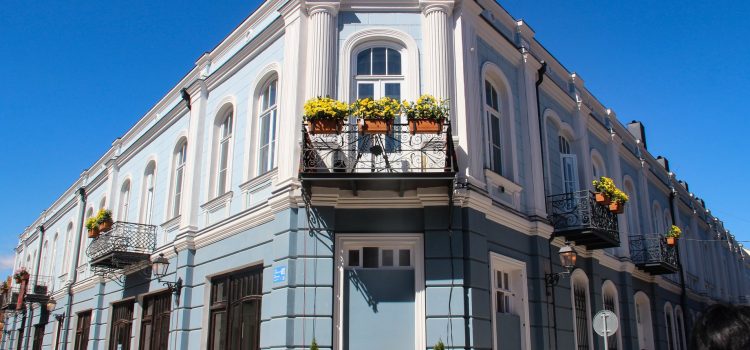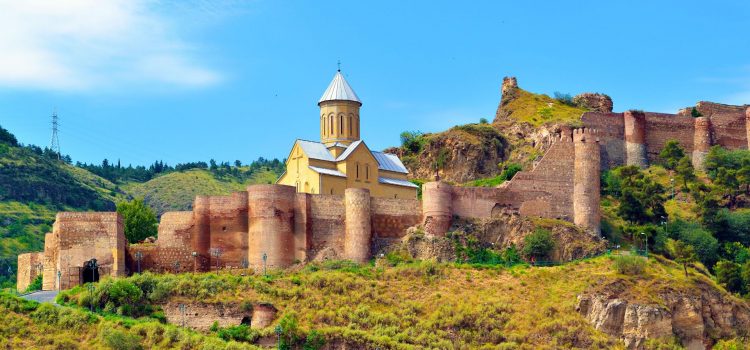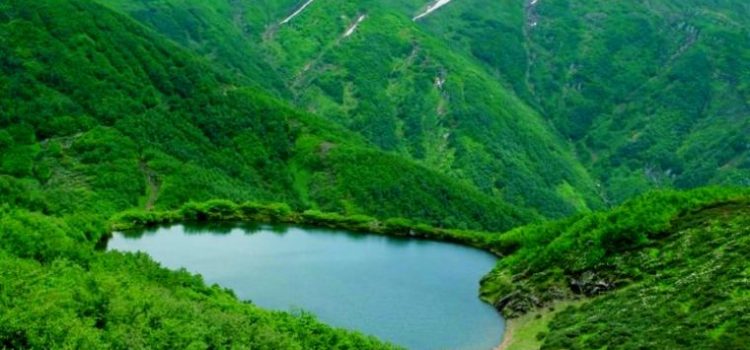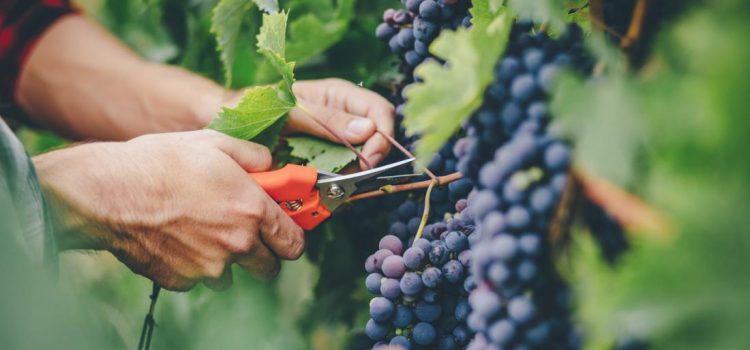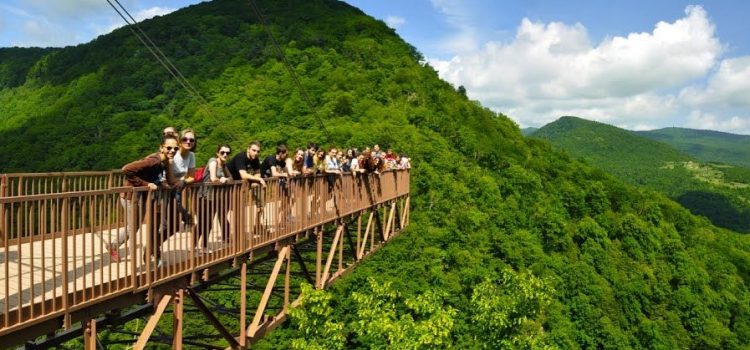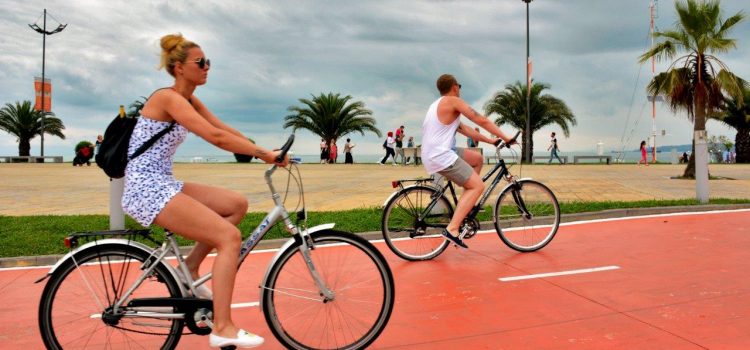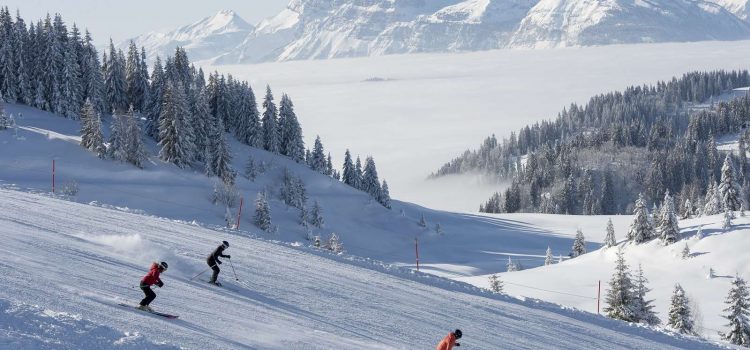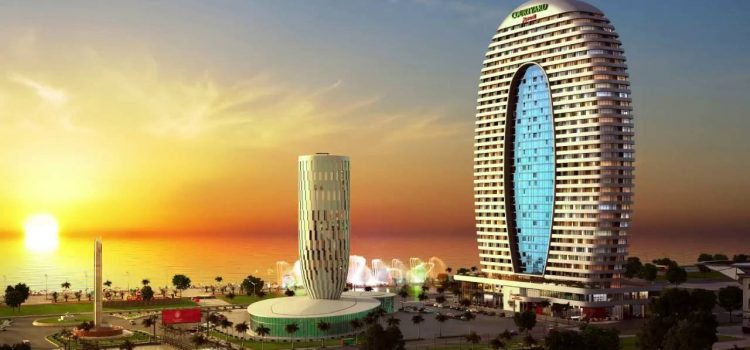Holy Trinity Cathedral of Tbilisi
The Holy Trinity Cathedral of Tbilisi commonly known as Sameba is the main cathedral of the Georgian orthodox church, located in Tbilisi, the capital of Georgia. Constructed between 1995 and 2004, it is the third tallest Eastern Orthodox cathedral in the world and one of the largest religious building in the world by total area. Sameba is a synthesis of traditional styles dominating the Georgian church architecture at various stages in history and has some Byzantine undertones.
The idea to build a new cathedral to commemorate 1,500 years of autocephaly of the Georgian Orthodox Church and 2,000 years from the birth of Jesus merged as early as 1989, a crucial year for the national awakening of the then Soviet republic of Georgia. In May 1989, the Georgian Orthodox Patriarchate and the authorities of Tbilisi announced an international contest for the “Holy Trinity Cathedral” project. No winner was chosen at the first round of the contest when more than a hundred projects were submitted. Finally the design by architect Archil Mindiashvili won. The subsequent turbulent years of civil unrest in Georgia deferred this grandiose plan for six years, and it was not until November 23, 1995, that the foundation of the new cathedral was laid.
The construction of the church was proclaimed as a “symbol of the Georgian national and spiritual revival” and was sponsored mostly by anonymous donations from several businessmen and common citizens. On November 23, 2004, on St. George’s Day, the cathedral was consecrated by Catholicos Patriarch of Georgia Ilia || and high-ranking representatives of fellow Orthodox Churches of the world. The ceremony was also attended by leaders of other religious and confessional communities in Georgia as well as by political leaders.
The Sameba Cathedral is erected on the Elia Hill, which rises above the left bank of the Mtkvari river in the historic neighborhood of Avlabari in Old Tbilisi.
Source: Wikipedia.com
Georgia must see place: David Aghmashenebeli Avenue
There are many must see places in Tbilisi, but now we want to speak about David Agmashenebeli Avenue
It’s one of the main avenues in the historical part of Tbilisi, known for its 19th-century classical architecture. The avenue is located on the left bank of the Mtkvari river, and runs from Saarcbruken, Square to Giorgi Tsabadze street. Currently named after David |V of Georgia, it was originally called Mikheil Street in 1851, and Plekhanov Street after the Russian revolutionary George Plekhanov, from 1918 to 1988.
Since 2010, the avenue has seen major rehabilitation works, which includes the renovation of seventy buildings, as well as the road, sidewalks and street lighting.
Agmashenebeli is easily accessible by metro at Marjanishvili metro, which is a single stop away from the city’s second historical artery – Rustaveli avenue.
Source: Georgia.travel
Photo: Tbilisi development fund
Narikala Fortess in old Tbilisi
Narikala fortess- also called the Mother Fortress of Tbilisi, Narikala is an ancient symbol of Tbilisi’s defence. The fortress was established in the 4th century, around the period when the city itself was founded. It was then known as Shuris-tsikhe (Invidious Fort). The name Narikala is said to derive from a Persian word for citadel, but another theory says was the name that Mongols used, meaning “little fortress”. It was expanded considerably by the Arabs during the 7th and 8th centuries. The Arabs built the Emir’s palace within its walls. King David further extended the Builder the fortress in th 11th century. Most of the existing fortifications date from the 16th and 17th centuries. In 1827 it was damaged by an earthquake and was not resorted. St. Nikolos church, inside the fortress walls, dates from the 12th century. It was renovated in 1996. Narikala offers you some of the best panoramas of the city.
We’d also advise you to take a walk along the Narikala Tourist route, a 1500 metre trail that runs from the top of the ridge near the Mother Georgia statue, around the fortress and down into Old Town to near the entrance to the Botanical Gardens. It offers stunning views at every turn and is a particular delight at night when the city lights shine below.
source: www.inyourpocket.com
Mtirala: Georgian nature at its purest
It is pure, unblemished nature…
Yet the Mtirala National Park can be found just 40 kilometres from Batumi, the capital city of Georgia’s autonomous republic of Adjara.
“We’re lucky to have the sunshine: this Adjarian national park, Mtirala, is considered Georgia’s rainiest spot of land,” said Euronews reporter Denis Loctier, as he explored the region.
In this high humidity, the air is fresh and fragrant with blooming flowers and herbs.
It’s a protected site for the region’s flora and fauna, including rare and endangered endemic species.
“Mtirala translates as ‘a weeping mountain’. This place is often clouded in mist and drizzle. That’s where the name comes from,” explained park guide, Zia Kontselidze.
At 1,500 metres above sea level, Mtirala’s trails are perfect for hiking, bird watching and adventure tours.
Source: Euronews.com
Evidence of ancient wine found in Georgia a vintage quaffed some 6,000 years BC
Archaeologists are hard at work sifting through the dirt at a dig in Imiri, south-eastern Georgia.
The scientists believe that the site contains artefacts that could once and for all prove that Georgia is the oldest wine producing country in the world.
Eight thousand years ago, during the neolithic era, farming and agriculture were flourishing in the three villages that now make up the Shulaveri – Shumitepe Cultural ruins in Marneuli Valley.
And one of the products being grown and harvested proved to be grapes to make wine.
Stephen Batiuk is from the University of Toronto: “What is significant about this site is that it produced some of the earliest examples of domesticated grapes, which we believe were involved in the earliest production of wine. We know that a wine vessel was discovered in Shulaveri, which also provides evidence of early wine production. But here (Imiri site) wine could be produced even earlier taking wine production in Georgia all the way back to 6,000 BC.”
David Lordkipanidze, is director of Georgia’s National Museum:
“The aim of this project is to look at the history of agriculture. It’s not just only the question of the earliest wine and we have found here traces of very old wine making, but as well to look at the domestication of the weeds, of the different agricultural products, which shows that Caucasus and Georgia were part of this big geographical territory, the so called Fertile Crescent, where the earliest agriculture was appearing and first civilisations were spreading.”
The Fertile Crescent is a swathe of land stretching from upper Egypt to Mesopotamia, modern day Iraq, Kuwait and northeast Syria.
Source: Euronews.com
Georgian Adventures: Okatse Canyon
Georgian adventures continue at the Okatse Canyon near the village of Gordi in the country’s west.
“This area close to Kutaisi is famous for its deep canyons, forest lakes and other fascinating natural attractions,” said Euronews reporter Denis Loctier, trying out a new footpath with vertiginous views.
The 800 metre footpath is visited by 150,000 tourists a year and there are plans to boost the experience further by making its floor transparent!
“The thrill of walking over the canyon attracts many visitors,” Okatse Canyon Director Zaza Gagua told us.
“This is the only place in Georgia where you can really feel this, so it’s not often that people are so frightened that they turn back!”
And if you’re a true adrenaline junkie, you can test yourself by rappelling down Kinchkha, one of Georgia’s tallest waterfalls, with its refreshing cascade of clear mountain water.
source: Euronews.com
Georgian Adventures: Pedal power in Batumi
n this episode of Georgian adventures, we jump on one of the hire bikes in Batumi, the booming capital of the Autonomous Republic of Adjara.
“Batumi is one of Georgia’s largest cities and its best known Black Sea resort,” said our reporter Denis Loctier as he peddled along the promenade.
“This coastline boulevard is Batumi’s most famous attraction!”
What originated in the late 19th century as a seaside boardwalk is now a lush seven-kilometre park promenade with dancing fountains, modern sculptures, beach bars and cafés. It is a great place for a leisurely stroll and, even better, for a scenic two-wheel ride.
Pedal-friendly whatever the weather, Batumi is stunning for bike-lovers when the sun shines!
“A bicycle is a very convenient way to see the main attractions of Batumi,” said local student and cycling enthusiast Maia Japaridze.
“It’s not a very big city. You could walk across it in a day and if you get a bike you can get around Batumi very quickly.”
The city is lined with bicycle lanes, offering picturesque views and a refreshing breeze to those who prefer their seaside vacation in the saddle!
Source: Euronews.com
Georgian Adventures: Georgia is also a place to ski!
In our Georgian adventures, the sky is the limit as we discover the country’s most popular destination for ski holidays!
“The Greater Caucasus is Europe’s highest mountain range and this is where we find Georgia’s best known ski resort – Gudauri,” declared our intrepid reporter Denis Loctier as he paraglided into the zone, with an instructor.
The slopes in Gudauri reach an altitude of 3,300 metres above sea level, so the skiing season begins in early December and lasts until the end of April.
The resort is famous for its snow quality and skiing infrastructure — the most developed in Georgia.
“Gudauri is the largest ski resort in our country and the closest to the capital,” said one enthusiastic skier, Nino Tkavadze.
“I think it has huge potential with the diversity of mountains around here!”
Accessible from Tbilisi in less than two hours, Gudauri offers 70 kilometres of ski runs, unlimited off-piste opportunities and a choice of extreme adventures like heli-skiing and speed riding.
Source: Euronews.com
Euronews: Traditional Georgian Ballet is the Classics plus Folklore
Euronews correspondent Wolfgang Spindler went to Tbilisi to find out more about traditional Georgian ballet.
The Sukhishvili Georgian National Ballet combines traditional Georgian dances, ballet, and elements of modern dance. With fast turns and acrobatic jumps, the dancers can easily captivate an entire audience, young and old. The ensemble has performed at some of the world’s most prestigious performance spaces.
The company began 70 years ago when Iliko Sukhishvili and Nino Ramishvili, a husband and wife team, created their own dance ensemble. Since then, they have survived the Stalinist terrors, the Cold War, and the collapse of the USSR to build international recognition. Today, it’s the grandchildren who are in charge. Iliko Sukhishvili the younger is the Artistic Director, and his sister Nino is the General Director and Costume Director.
The group’s repertoire includes dances from the various regions in Georgia, featuring traditional costumes from these same regions. Some dances from mountainous regions are reminiscent of fights, or agility and courage competitions.
You can see a performance of the Sukhishvili Georgian National Ballet at Rike Park in Tbilisi every Saturday through August 25.
Source: Euronews.com
Batumi to Host International Rural Tourism Conference
The second International Conference of Rural Tourism will be held in Batumi on October 19-20. The main topic of the conference will be “Rural Tourism as Business”.
The conference will present presentations, reports and seminars by invited Georgian and foreign experts, and introductory practical visits will be arranged on tourist routes throughout the Adjara region.
The topics of the Conference include:
Village and village life as a tourist product, business and source of income;
Innovative services and tourist products to maintain rural / village authenticity in parallel with innovative services;
Rural tourism development prospects and challenges in the Adjara region/tourist infrastructure in rural areas;
General standards of rural tourism (service standards, types of family guest houses, etc.);
Georgian hospitality and hospitality as a business;
State programs in rural tourism development in Georgia and other countries;
Competition in rural tourism, positive and negative impacts and sides of the competition;
Attracting tourists in rural areas and advertising.
The conference will be attended by the owners of family guest houses, tourist agencies, the representatives of the different fields of rural and eco-tourism, as well as the representatives of governmental and non-governmental organizations.
“In the Adjara region, rural tourism is at the initial stage of development, so it is important for us to get acquainted with the international experience and successful business examples of rural tourism.
“Although the locals of Adjara region have started to actively engage in tourism sphere and the number of the providers of family guest houses and other tourist services is significantly increasing, there is still a lot of work in the direction of tourism business development,” said Tinatin Zoidze, Director of Tourism Products Development Agency of Ajara Tourism Department. “Accordingly, we need to get acquainted with other people’s experiences and use it in practice. This is the main goal of our conference and I think that we will have interesting speakers this year, too.”

